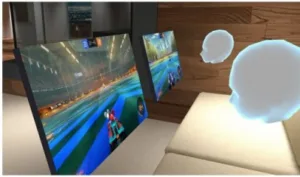As virtual reality moves towards becoming a consumer reality, it still remains essentially a solitary user experience. There are a variety of reasons for this not the least of which is the fact that users wear a Head Mounted Display that isolates them from the surrounding environment. This issue is being addressed by BigScreen, Inc.
Although details on the BigScreen system are still sparse, the company has just emerged from stealth mode and the general concept and capabilities of their product have become public.
The company’s app provides users access to their computer desktop while in the VR environment. With BigScreen, any program can be launched, and anything that would appear on the user’s monitor can be seen and shared inside the virtual environment. Specific examples of this includes access to data, files, apps, web pages and games that reside on the user’s computer. It is also possible to communicate over Skype and for multiple users to simultaneously watch streaming videos from a variety of sources including You Tube or the user’s hard drive. The main point is that users are not limited to content or apps specifically designed for VR. Most importantly, access to all these capabilities are provided without the user having to take off their HMD.
With BigScreen, the user’s Windows desktop is presented on a 20 foot screen inside the virtual environment. In addition to and alongside that screen, it is possible to:
- Place shared desktops and screens from friends.
- Play games in a virtual reality LAN party in which guests are represented by avatars.
- Communicate with friends using 3D Positional audio chat.
- See friends and what they are viewing. The friends are represented by synchronized heads.
- Collaborate on projects.
- It is possible to project the display on a VR wall to make it more visible to anyone in the same VR room.
Some of the capabilities described for BigScreen may sound a little familiar. For example, Convrge or Oculus Social Alpha, bringing together up to four people in the same space representing them as avatars and allowing them to chat. This capability differs from the BigScreen approach in that BigScreen users also bring with them into the social space their actual desktop computer screen. With this screen, users can do anything they could do on their computer and everyone else in the room can see what is on the screen.
At this time, BigScreen supports the Oculus Rift and HTC Vive. The company has stated that BigScreen will soon also be on mobile VR devices.
BigScreen is now accepting public beta registration on their website. The company is targeting a full launch on the Oculus Rift and HTC Vive in April, with Samsung Gear VR support to come later this year.
Looking towards the future, the company has stated that new features will be added to the system. “You’ll be able to easily move and adjust the screen in front of you, use a laser pointer, and even customize your avatars.” Longer term, the company has stated the belief that “Anything that we do on screens in the modern world – on smartphones, TVs, and laptops – will be done in VR, and soon AR.” -Arthur Berman

